With my newly found confidence in the sport, the next kayaking adventure presented itself. This time it came in the form of the San Juanitas gourmet kayak expedition in the San Juan islands off the Washington coast. Savor Seattle partnered with the San Juan Outfitters to promise us “pampered paddling” on a guided three-day kayak and camping getaway. There would be wildlife viewing – orcas and seals and osprey -from a sea-level view. We would be afforded stunning views of the islands and the sun setting golden in the ocean. Instead of freeze-dried camping fare we would enjoy braised short ribs and grilled salmon and salted caramels, all paired with Washington wines. I could certainly paddle for food and wine! I signed up immediately.
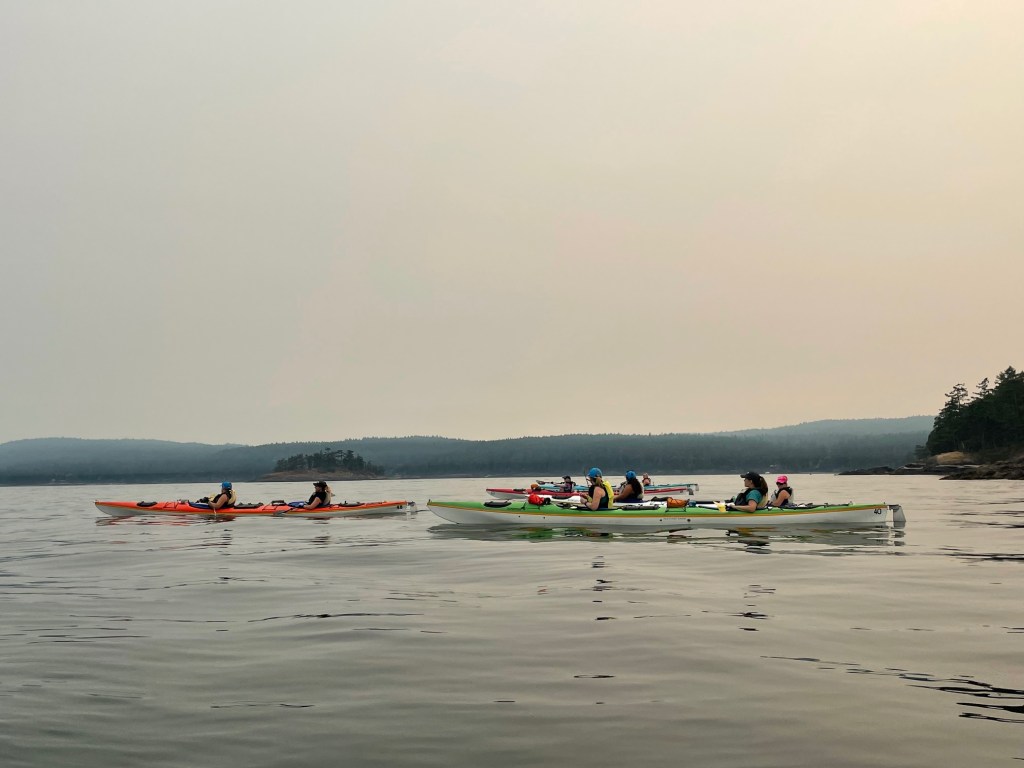
Our group consisted of seventeen women, some newcomers, some seasoned paddlers, all eager to try sea kayaking for a long weekend. The Alaska component of our group met at the Fairbanks airport to travel south to Seattle. We met up with friends from Colorado, Oregon, Utah and Washington, then travelled onwards to Anacortes where we caught the ferry to Friday Harbor on the San Juan islands.
Our preparations had taken some time. Our outfitter guides had sent us a packing list of clothing and items that we were meant to cram into two tiny dry bags. Quick dry pants, shorts, T-shirts, hiking shoes, paddling gloves, flashlight, towel, long underwear, wool hat, sandals, ballcap, sunscreen. There was no way all of it would fit. I eyed the miniscule space of my 20-liter and 5-liter drybags, which would have to be accommodated into my kayak. Contemplating the favorable weather forecast, I started pulling clothing back out of my pack. We would simply all be stinky and disheveled together, I decided.
In Roche Harbor, our kayaking departure point, we sat on a grassy lawn near the harbor, munching on chicken skewers and black bean salad while our guides gave us instructions. We listened as they told us how to put on the kayaking “skirt” and strap ourselves into the wobbling vessels, how to extract ourselves from these should that be necessary and how to efficiently paddle without immediately exerting all our energy. When we paired up, we were told that the more “confident” paddlers should climb into the three-person kayaks. I’m not sure how Dawn and I managed to end up in one of these. It was not until the end of the paddling day that we realized that our kayak was twice as heavy as everyone else’s because we were carrying camp stoves and tents and dozens of wine bottles.
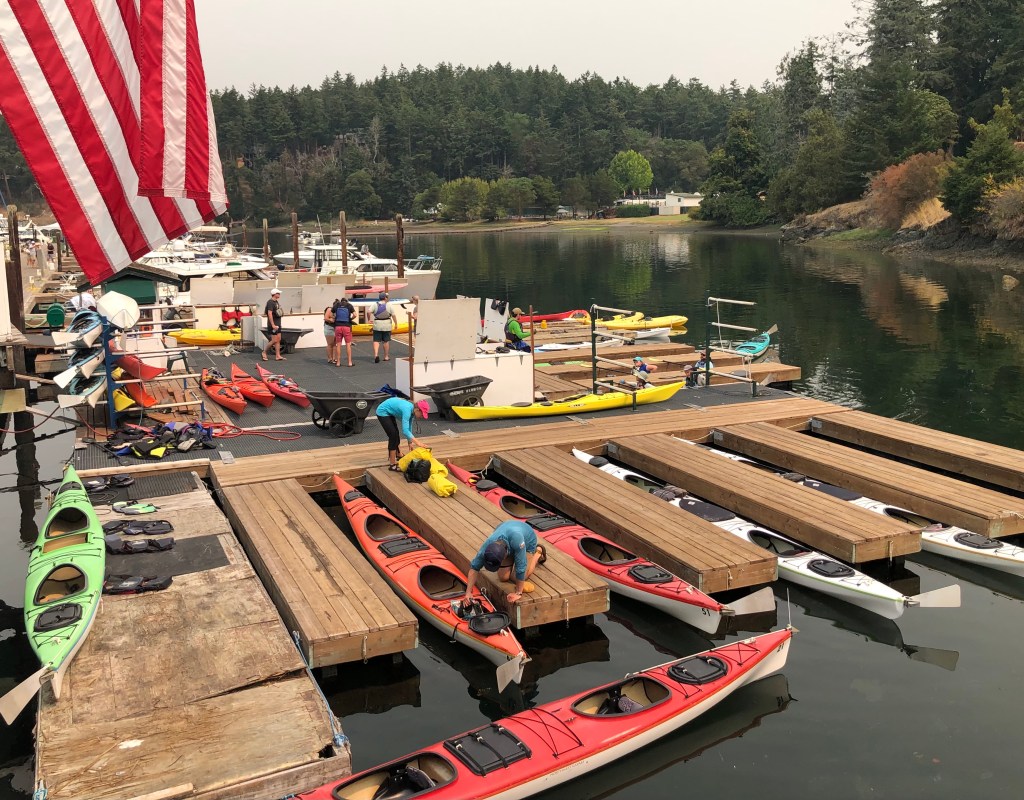
We paddled along the northern shore of San Juan Island, close enough to shore to make out beautiful coastal homes and gardens. Even though Erik, one of the guides, assured us that our destination was “just around the next bend” we paddled nonstop for hours in the Spieden Channel. Many coves later, we just laughed at him. Plus, where was the current assist that he had promised us? I started to worry about a bathroom break, given the fact that we were a group of middle-aged women, but our guides had evidently taken that into consideration. We stopped at a beach with an outhouse.
Next came “the crossing” of the San Juan Channel, to my eyes a wide swath of ocean. We needed to traverse this to get to Jones Island where we would spend the next two nights. Mustering our arm strength, we stoically got into our boats again, remembering that there would be a nice dinner at the end. The group hoped for orca sightings. Someone mentioned that kayakers, from an orca’s viewpoint below, look like seals and thus believe them a credible food source. I swallowed and paddled even harder, keeping my eyes resolutely on the distant outline of Jones Island, our destination.

Cara, Danielle and Erik, the guides, each had their own unique traits. Erik was great at bolstering us when our arms grew limp, paddling his kayak up next to us to point out rip currents and rocks to avoid. Danielle knew to impart information on just about any topic we asked her: geological formations on the San Juan islands, the type of seaweed kelp we were drifting through, different cone-like barnacles that clung to the rocky shoreline. Cara took time to explain the maneuverings of sea kayaks and maritime terminology to us, always with a smile on her face.
Jones Island had no resident population except for deer and raccoons. There were two campgrounds, one with and one without water. To add to our adventure, we set up camp on the latter. While our guides busied themselves with food preparation in their amazingly efficient workstation “kitchen,” the rest of us embarked on setting up tents and sorting out sleeping bags. Dinner, after our long day, consisted of salmon, mixed greens with mustard dressing and black rice salad. Needless to say, it tasted heavenly.
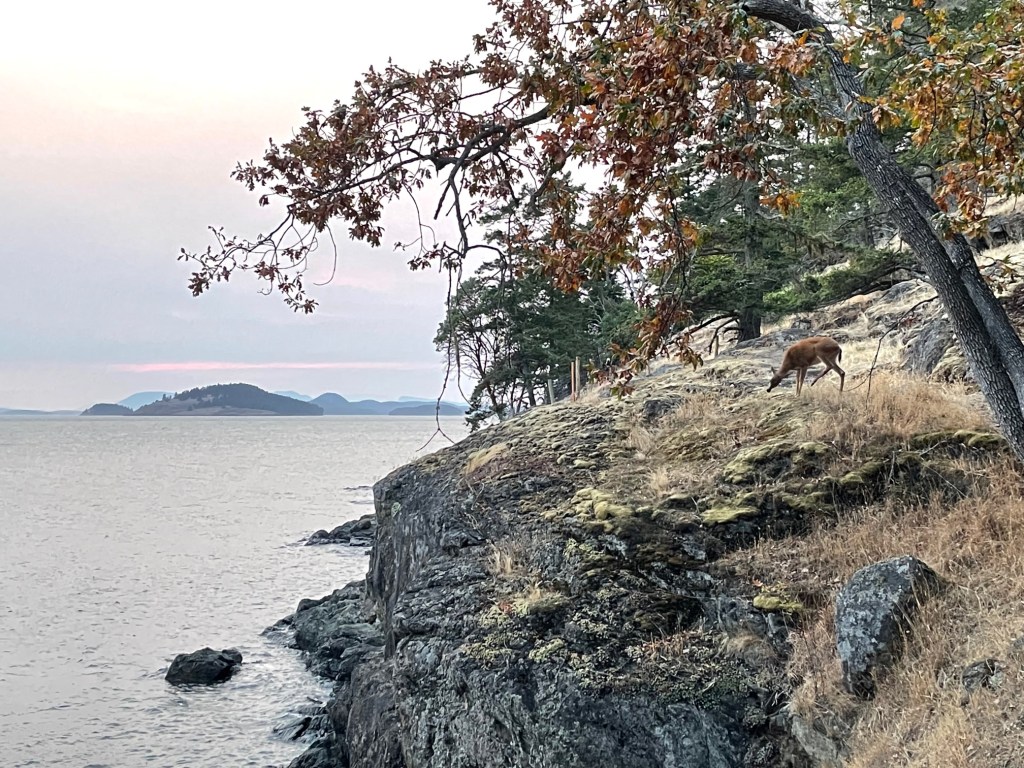
Over the next couple of days together, we got to know each other. There were three “Taras” in our group, a challenge when we called for one of them in particular. Karina was adept at setting up tents, a skill we immediately pounced on. Rebecca, Steph and Jen started a game of cards one afternoon while the rest of us non-card players quickly scattered. Tessa led us in a Zumba dance lesson. We enthusiastically swayed our hips to Shawn Mendes and Camila Cabello’s “Senorita,” never knowing we had it in us. When our unbathed state became too much, we challenged each other to a dip in the cold bay, one that only a scarce few of us took upon us. Over another fabulous dinner, we talked about books we had recently read and tea that was best brewed in a “Teaze” and Jack from “Virgin River.”
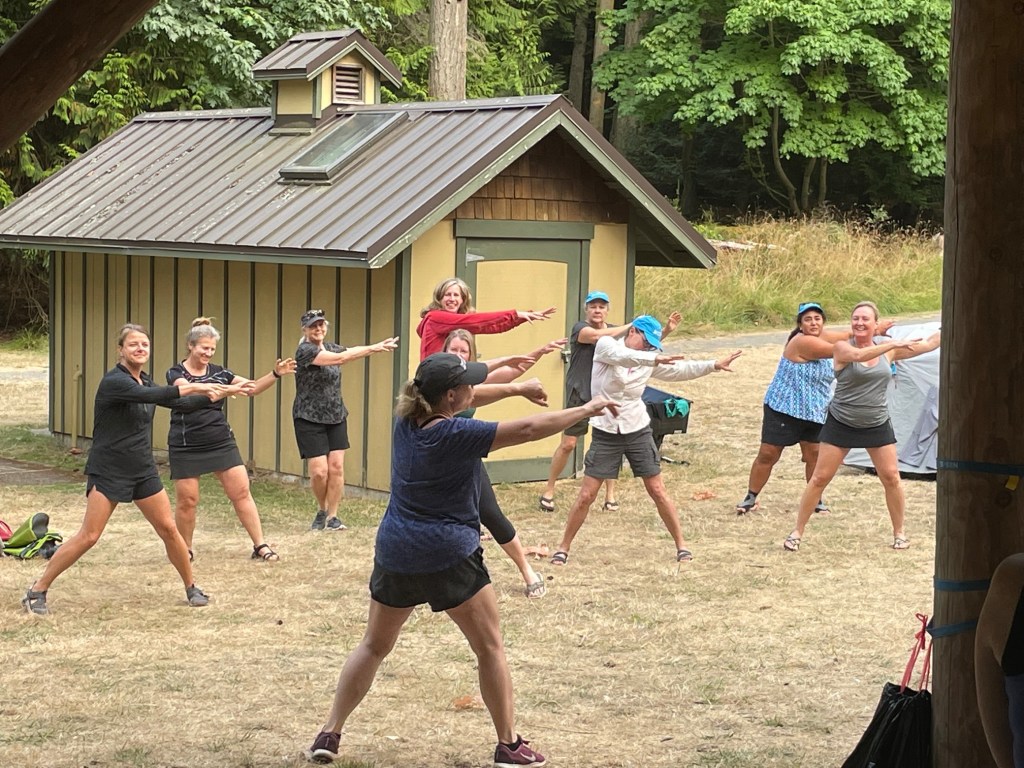
The next morning, amid groans of “I’m too old for tent camping!” we squeezed ourselves from our sleeping chambers. A group hike was organized to loosen our stiff muscles. We followed a loop trail down the center of the island, then skirted its western perimeter. We crested hills and walked right on the bluff overlooking the water. We came across Madrone trees, with red peeling barks and a fruit tree orchard, remnants of early homestead settlers of the island. Everywhere there were deer that were quite habituated to the presence of humans. Near the other campground, we learned that it not only had the coveted water spigots but also the “Jones Island Public Library,” an outhouse with a shelf of books.
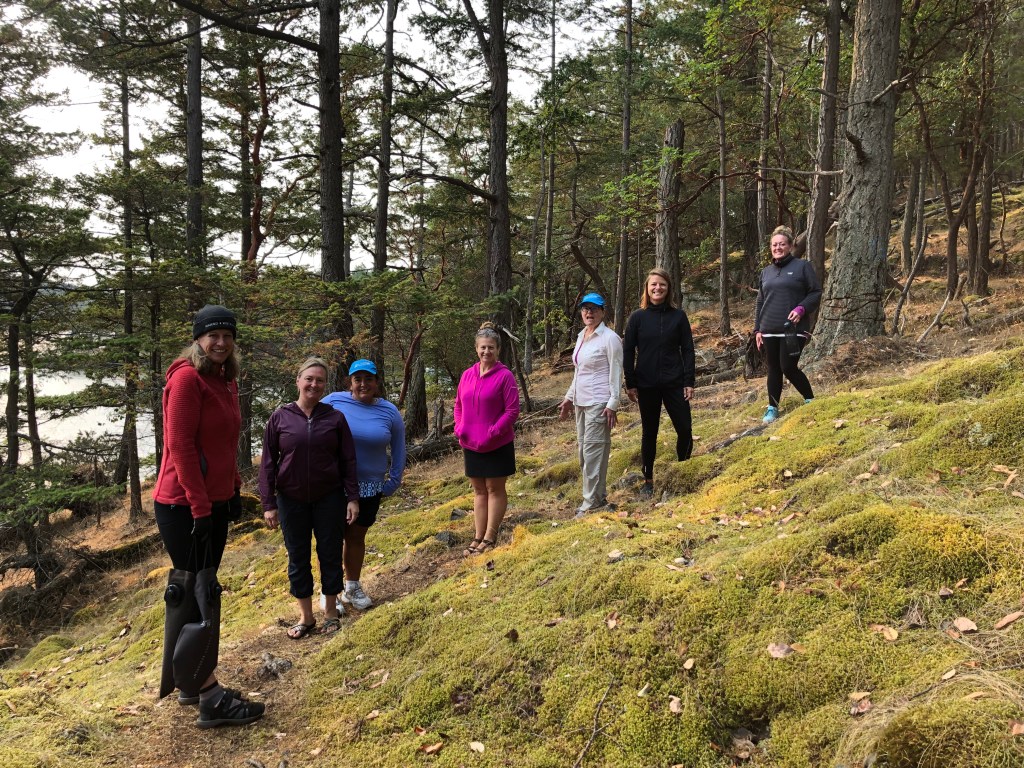
In the afternoon we took the kayaks around the entire island. We came across seal pups sunning themselves on rocks. Some poked their heads out of the water curiously to watch us paddle by. The sun made the bay glitter. Our spirits were lifted. To our delight (and thankfully from shore) we saw two orcas glide elegantly by, their dorsal fins breaking out of the water in one smooth movement before they disappeared beneath the surface again. That evening, we sat together to watch the sun set into the bay. It had been a perfect day.

On the day of our return voyage, our guides suggested waiting until the tidal currents would work in our favor. We didn’t think anything of it, not even when Erik suggested we do some stretching and relaxation exercises on the beach before our departure. Perhaps we should have heeded a warning when he asked whether anyone needed seasickness tablets before we climbed into our kayaks. The channel was choppy and the wind came at us sideways. Within minutes we were drenched. One of the guides explained that the waves could be measured as three or four feet high when the people in the kayak next to one’s own disappeared from view behind the next wave. Valiantly, we paddled on, measuring our distance by a small island mid channel that we seemed to never pass. We made it across eventually, even though our journey back to Roche Harbor took us twice as long as we expected.
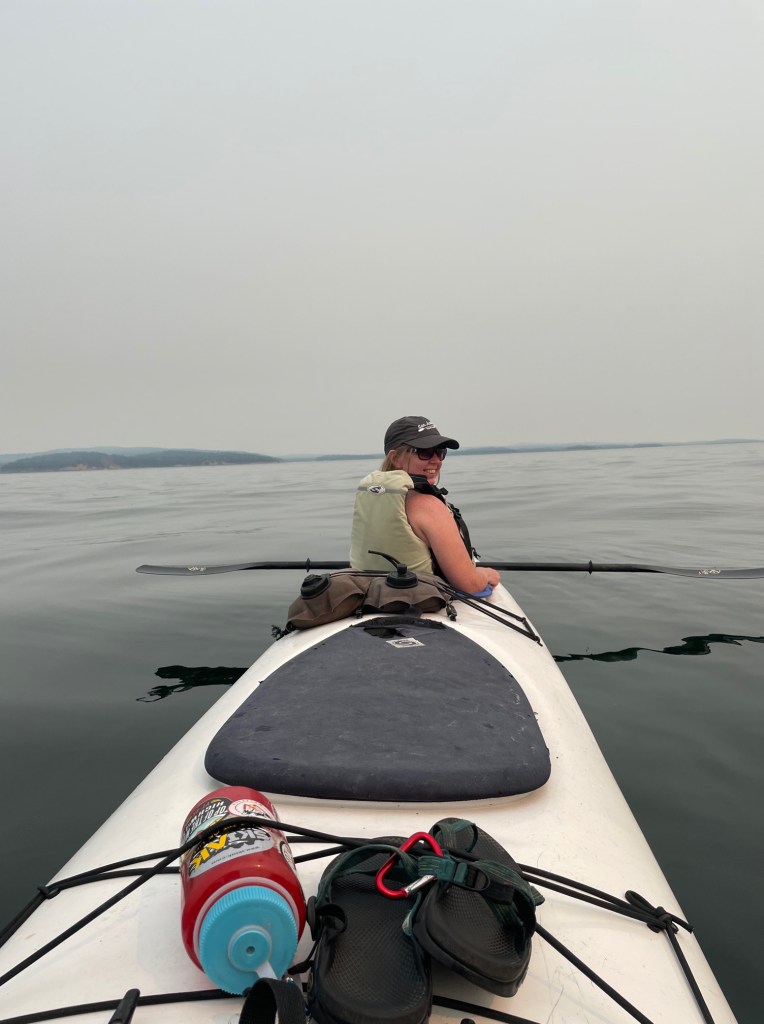
Tired but fortified by our seafaring adventure, we parted ways, exchanging numbers, promising to stay in touch. Our thalassic weekend had given us all it had promised. And a few new friends.






